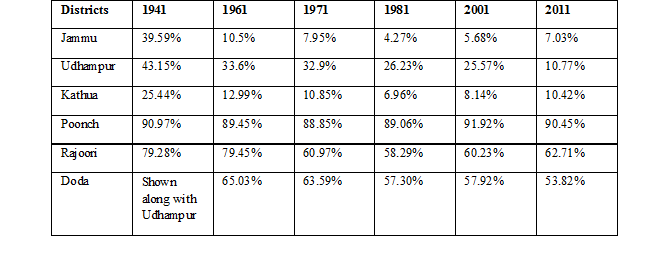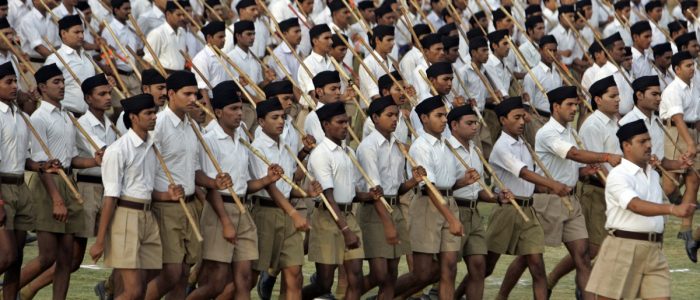For almost seven decades, the issue of Jammu and Kashmir continues to remain the main dispute between two nuclear-armed neighbours India and Pakistan. The Jammu and Kashmir issue, is one of the oldest unresolved international disputes, which continues to threaten the stability of the region which is home to three nuclear powers (China is the third nuclear power in the region). Since 1947, India has made numerous attempts to alter the demographics of Indian-held Jammu and Kashmir (IHK) to transform Kashmiris into a minority by converting the IHK into a Hindu-majority state.
The IHK is home to more than 12.5 million people and is divided into three administrative divisions –Jammu, Kashmir Valley and Ladakh. Originally, the IHK had 14 districts – six each in Kashmir and Jammu and two in Ladakh. In terms of distribution of religious groups, ten of these districts were Muslim majority – six in Kashmir, three in Jammu and one in Ladakh. In addition, there were three Hindu-majority districts and one Buddhist-majority districts. In 2006, eight new districts were created, increasing the number of districts to 22. Of these 22 districts, there are 17 Muslim-majority districts – 10 in Kashmir, six in Jammu and one in Ladakh, three Hindu-majority districts and one Buddhist-majority districts.
Table 1 shows that the percentage of Muslim population in IHK is nearly the same as that of 1961. Contrarily, the percentage of Muslim population in India has increased from 10.70% in 1961 to 14.23% in 2011. Dr Sheikh Showkat, in his booklet titled Kashmir: Palestine in the making, has enumerated several reasons for the decline of the population of Kashmiri Muslims.

Genocide and ethnic cleansing are considered as the major factors behind the decline of the Muslim population in the early years of Indian rule in IHK. Hundreds of thousands of Muslims from Jammu, Kathua and Udhampur districts were massacred whereas many were made to migrate. Ian Stephens, a former editor of The Statesman, described the situation in the following words:-
“….Half a million or so, had almost totally disintegrated in the autumn of 1947.About 200,000 simply vanished, being presumably butchered or killed by epidemics and exposure while seeking to get away; the rest had fled into Pakistani Punjab”
Consequently, the Muslim population of IHK declined from 78% to 69% between 1941 to 1961. In addition, the settlement of non-state subjects within the state is also an important factor for the decline of the Muslim population in several districts of IHK. Settlement of non-state subjects in various districts of Jammu from India stated immediately after 1947. Rashtriya Swayamsewak Sangh (RSS), regarded as the parent organisation of BJP, has openly advocated the policy of transforming the demography of IHK by settling Hindus in IHK. Table 2 shows the decline of the Muslim population in several districts of Jammu division.

Following the formation of BJP-PDP coalition government in March 2015, the IHK government decided to take various steps in order to bring demographic changes in IHK. In this regard, the government announced the decision of setting up Sainik colonies to permanently settle Indian soldiers and build townships to settle displaced Kashmiri Pandits in IHK. Attempts to setting up colonies for Indian soldiers are in complete violation of the Fourth Geneva Convention. Under Article 49 of the fourth Geneva Convention, the occupying force shall not deport or transfer part of its own civilian population into the territory it occupies. Therefore, India does not have the right to settle its own population in the IHK. Similarly, the displacement or transfer of local populations in IHK for the setting up of Sainik colonies and townships exclusively for Kashmiri Pandits is also illegal under international law. The recent decision to grant domicile certificates to the West Pakistan refugees (WPRs) is seen as one of the latest measures adopted to alter the demographics of IHK. The WPRs, estimated to be between 250,000-500,000, are those non-Muslims, mostly Hindus, who migrated from Pakistan to IHK at the time of 1947 partition. Apart from these measures, BJP has reiterated several times its commitment to abrogate Article 370 of the Indian constitution, which grants special autonomous status to IHK.
It is also believed that Indian census department is involved in the fabrication of IHK’s census figures. According to 1971 census, there were 12,740 Urdu speakers in the state. But the figure of Urdu speakers reduced to 6,867 in the 1981 census. Despite being the official language of IHK and attracting the widest readership of mass media, it is inconceivable to reconcile with the figures of census department. From time to time, various Kashmiri politicians and Hurriyat leaders have also raised the allegations of tinkering figures.
Meanwhile, the issue of the return of Kashmiri Pandits is also seen by Hindus as an attempt to decrease the Hindu population in IHK. Kashmiri Pandits, estimated to be not more than one lakh, have the right to return to IHK, but to reside them in selected townships is seen by Kashmiris as an attempt to create social discord in the IHK.
Kashmiri leaders accuse BJP of using the plight of the displaced Kashmiri Pandits to change the ethnic and religious demography by settling ‘Hindu extremists’ along with the Pandits to create social discord in the valley.
Policies aimed at altering the demographics of Kashmir have created discontent and restlessness among Kashmiri youth. The 2008 uprising started following an agreement between Indian central government and IHK government to transfer 99 acres of Kashmir Valley’s forest land to the Shri Amarnathji Shrine Board to set up temporary shelters and facilities for Hindu pilgrims. Indian government’s policies to alter demographics of IHK will meet with more resistance from Kashmiris in future.
Instead of wasting time and efforts in altering the demographics of IHK, the Indian government should give the people of IHK the chance to express their desire, through the UN-supervised plebiscite, to accede to either India or Pakistan. This major step can help India to focus more on other important internal issues and will pave the way to resolve other outstanding issues between India and Pakistan. Resolution of key issues between Pakistan and India will help to bring much-needed stability in the region.
